Brain Anatomy & Functions
How Birth Trauma Can Harm Your Baby’s Brain
The human brain is a complex, multi-faceted command center that directs the rest of the body’s activities and processes. So, anything that harms a person’s brain affects that person’s ability to function.

It’s especially tragic when brain injuries happen at the very beginning of a person’s life. For example, newborn babies can sustain brain injury before, during, and after entering the world. And while physical impairments may be obvious soon after a child is born, brain damage often appears later in life.
Some brain injuries are preventable. But medical providers – doctors, registered nurses, midwives, and hospital administrators – did not protect and properly treat the mothers and infants in their care.

Babies that sustain birth injuries often suffer lifelong disabilities. Brain damage can manifest as children grow and start missing developmental milestones. However, their condition depends on what part of the brain was injured, how the injury occurred, and whether appropriate treatment was given to the mother, the infant, or both.
Let’s start by looking at the different parts of the brain and what functions they control.

Basic Brain Anatomy
Overall, the brain sends and receives messages, interprets signals, and sends information to other parts of the body through the central nervous system. But different sections of the brain take on specific functions including movement, speech, heart rate, breathing, and thinking.
The brain is covered by three layers called:
- Dura mater: Veins and arteries pass through this thick, tough layer to provide blood flow to the brain.
- Arachnoid: Consisting of a thin layer of connective tissue, this layer covers cerebrospinal fluid. This fluid cushions the central nervous system and removes impurities.
- Pia mater: This thin layer that closely hugs the brain also contains many veins and arteries.
Next are the three major parts of the brain: the cerebrum (covered by the cerebral cortex), the cerebellum, and the brain stem. Each region has several parts, which will be covered later. Finally, the deep brain contains several structures, including the following:
- Pituitary gland.
- Pineal Gland.
- Hypothalamus.
- Hippocampus.
- Amygdala.
- Ventricles and cerebrospinal fluid.

Blood flows to the brain through vertebral and carotid arteries. Brain damage can occur when this blood flow is disrupted or contains very little oxygen. Some damage can result in cerebral palsy, seizure disorders, and brain death.
We’ll primarily be concerned with the three major parts of the brain, how they function, and what happens they are damaged.
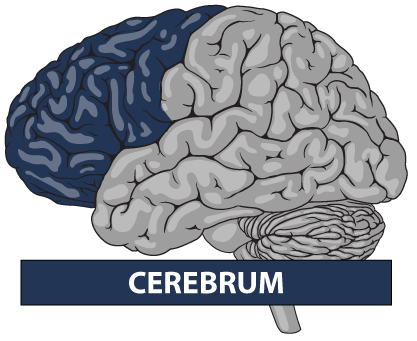
The Cerebrum
The largest part of the brain, the cerebrum consists of outer gray matter (the cerebral cortex) and a center comprised of white matter. The cerebral cortex is about half of the brain’s weight and is divided into two hemispheres (halves). The right hemisphere controls the left side of the body and vice versa.
Each hemisphere is divided into four lobes:
- Frontal: This is the largest lobe and is located near the front of the head. The frontal lobe affects movement, personality, decision-making, and speech. It also shares responsibility for the sense of smell with the temporal lobe.
- Temporal: In addition to smell recognition, the temporal lobe relates to short-term memory and speech. It’s located on the sides of the brain.
- Parietal: Located in the middle of the brain, the parietal lobe functions include understanding spatial relationships, pain, and touch.
- Occipital: This lobe is at the back of the brain. Its primary purpose involves vision.
The cerebrum handles the body’s most complex functions, including:
- Movement and motor functions,
- Temperature regulation,
- Cognitive abilities, including reasoning and thinking
- Interpreting sensory stimuli,
- Speaking and language,
- Emotions and sexual desire, and
- Bowel and bladder control.
The cerebrum can be damaged due to accidents, disease, and birth injuries. Babies with brain injury to the cerebrum may have the spastic form of cerebral palsy (CP). Symptoms of this common type of CP include stiff muscles, abnormal gait, and involuntary movements.
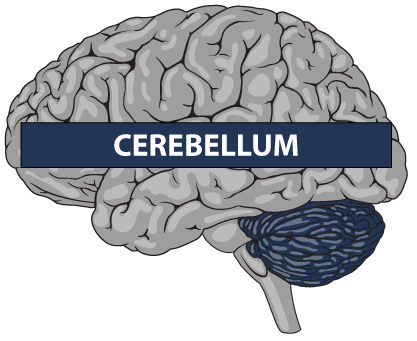
The Cerebellum
Sometimes called the “little brain,” the fist-sized cerebellum sits at the back of the brain. It’s just above the brainstem and below the temporal and occipital lobes of the cerebrum. The inner part of the cerebellum communicates with the cerebral cortex, which is part of the cerebrum.
This part of the brain controls the coordination of voluntary muscle movements using input from the eyes and ears. It is thought to affect or control posture and balance. Also, the cerebellum could be associated with emotions, social behavior, language processing, attention, and cognitive tasks.
Damage to the cerebellum could result in the following conditions:
- Ataxia causes uncoordinated movement and speech disorders. Someone with ataxic cerebral palsy will be shaky and have trouble with balance and posture.
- Dystonia causes spasms, muscle and joint contracture, and spasticity. Spastic cerebral palsy is the most common form.
- Tremors are involuntary muscle contractions. Many children with cerebral palsy also suffer from tremors.
Damage to the cerebellum can occur before, during, or after a baby is born. Sometimes medical professionals cause the injury through medical negligence or malpractice. Parents might consider filing a lawsuit against the responsible medical professionals in such cases.
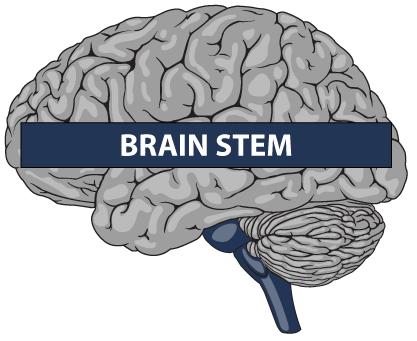
The Brainstem
The third major region of the brain is the brainstem. Situated in the middle of the brain, it connects the cerebrum and the spinal cord. The brainstem consists of three major parts:
- Midbrain: This complex structure controls hearing and movement. It also aids in calculating responses to changes in a person’s environment. The midbrain also contains part of the basal ganglia, which helps with motor skills and coordination.
- Pons: This section contains 4 of 12 cranial nerves and connects the midbrain and the medulla. Its purposes include chewing, blinking, focusing, and balance.
- Medulla: Located at the bottom of the brainstem, this connects the brain with the spinal cord. Its functions include many voluntary and involuntary acts, like breathing, heart rhythm, and blood flow.
Overall, the brainstem controls vital functions. These include a person’s respiration, blood pressure, and heart rate.

A baby born with injuries to the basal ganglia could have dyskinetic cerebral palsy. They will find it difficult or impossible to control their movements. For some, brain damage caused before, during, or after their birth could have been prevented had medical professionals done their jobs.
Birth-Related Brain Injuries
Hypoxic-ischemic encephalopathy (HIE) is a severe birth-related brain injury. HIE occurs when a baby suffers from oxygen deprivation, then the baby’s heart rate begins to show signs of fetal distress. Blood flow to the baby’s brain is reduced and contains less oxygen than the baby’s brain needs.

Reviewing fetal heart monitor strips is one way for doctors and nurses to recognize that a baby is in fetal distress. Once they see abnormal heart rate patterns, they need to act quickly to protect the baby’s brain. They may begin by changing the mother’s position to reduce pressure on the umbilical cord. If this and other interventions do not work, an emergency cesarean delivery might be performed.
Unless medical professionals intervene, oxygen deprivation can quickly cause severe and permanent damage. Physical signs of brain damage like hypotonia (floppy muscles) or seizures may be obvious from birth. However, other signs of brain injury may only be diagnosed after the child begins missing developmental milestones. For example, parents and doctors may not notice a child has difficulty walking until the child reaches the age where that milestone is expected.

Recognizing Neonatal Brain Injury
Newborn babies can exhibit certain signs and behaviors that indicate a potential birth-related brain injury:
- Seizures
- Sluggish, lethargic, and unresponsive to stimuli
- Abnormal muscle tone (too floppy or too stiff)
- Brain bleeds (hemorrhages)
- Bruising or lacerations of the baby’s head
- Difficulty feeding, latching on and swallowing
- Trouble breathing
- Umbilical cord tests indicating acidosis
- Low Apgar scores
Also, newborns with untreated Jaundice (hyperbilirubinemia) can develop kernicterus, which causes brain damage.
Some signs of brain injury are not noticeable until a child has grown, including:
- Physical Development: unable to sit up, roll over, or hold up head; unable to stand or walk normally, cannot use spoon and cup when eating, cannot climb up and down from furniture, cannot walk up and down stairs, makes involuntary movements and unusual eye movements, uses an abnormal posture.
- Cognitive Skills: does not reach for toys, fails to recognize objects, does not move items from one hand to the other, cannot find hidden items, has trouble following simple verbal commands, unable to sort shapes and colors, unable to play make believe or turn pages of a book, does not understand counting items or the concept of time, cannot learn to use the toilet without assistance.
- Social and Emotional Development: fails to recognize caregivers and strangers, does not show emotions, cannot play simple games like “peek-a-boo,” does not play with other children.
- Language and Communication Skills: fails to copy sounds they hear, does not recognize their name, does not use simple gestures like waving good-bye, fails to speak familiar words (like “no”), cannot form simple sentences.
During regular checkups, a child’s doctor will ask whether a child is doing thing that the average child of that age can do. When children miss important stages of development, doctors may perform additional tests to diagnose the problem. Early diagnose and treatment of brain-related birth injuries can help children reach their full potential.
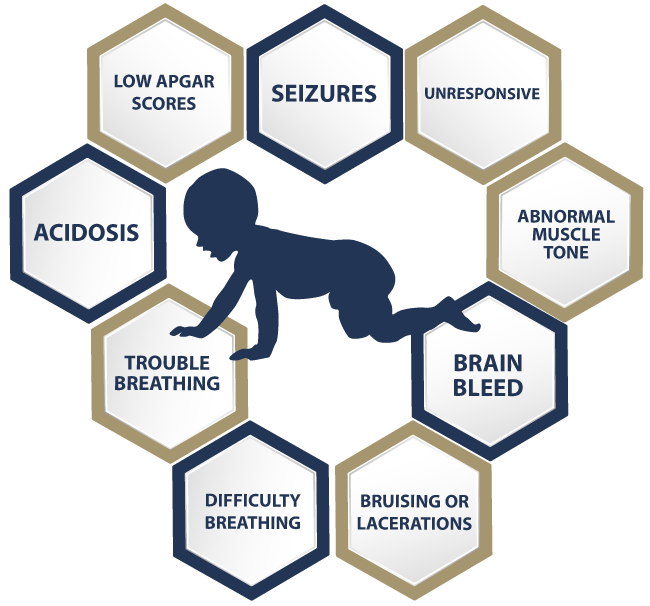
Prevention of Birth-Related Brain Injuries
Some brain injuries relate directly to pregnancy, labor and delivery, and neonatal care. Doctors, nurses, midwives, hospitals, and other medical providers might prevent brain injury by:
- Identifying high-risk pregnancies with medical conditions that can harm the fetus.
- Treating the mother and baby for issues that arise during pregnancy.
- Carefully monitoring the mother and baby during labor and delivery.
- Taking appropriate action when it appears the baby is in distress as indicated abnormalities on fetal heart monitoring strips.
- Delivering the baby quickly using forceps, vacuum extractors, or cesarean section (C-section).
- Monitoring the proper use of neonatal ventilators reducing over-ventilation of newborns; which leads to hypocarbia
- Providing neonatal resuscitation and treatment for hypoxic-ischemic encephalopathy (HIE), neonatal hypoglycemia, jaundice and kernicterus, and other neonatal conditions.

The parents of children with brain injuries may wonder if medical providers did everything they could for their baby. In some cases, medical malpractice or medical negligence played a role in their infant’s permanent brain damage. Parents may want to know what happened to their child. They also often want to know how to help their child going forward.
Recovery or Long-Term Disability
Babies with minor brain injuries may recover somewhat. However, they need prompt treatment from healthcare providers. For example, giving hypothermia therapy to a child with HIE could minimize brain injury or at least stop it from progressing.

But some babies with birth-related brain injury have lifelong disabilities. Some may show signs of cerebral palsy (CP) and face a wide range of physical and cognitive disabilities.
The extent of their disabilities depends on which part of their brain was injured:
- Cerebrum/Cerebral Cortex (also known as the motor cortex): Damage here affects movement. Spastic cerebral palsy, characterized by stiff muscle tone and spasticity, may result.
- Cerebellum: Damage to the cerebellum can cause muscle weakness (hypotonia) and poor balance and coordination (ataxia).
- Basal ganglia: Dyskinesia (uncontrollable movement) and dystonia (spasticity) can be caused by damage to the basal ganglia.
- Damage to multiple areas of the brain: A child with CP caused by this type of damage exhibits symptoms of more than one kind of CP.
Babies with brain damage, whether cerebral palsy or not, may need surgery, medical treatments, medications, therapies, highly skilled caregivers, and assistive equipment. All of this is expensive. The cost is usually more than the average parent can handle.
Is Your Child’s Brain Injury the Result of Medical Malpractice?
The parents of children who suffered brain injuries often want answers. They want to know what happened to harm their child’s brain. Were there signs of fetal distress that the doctors and nurses failed to recognize and/or failed to respond to in a timely manner?
Our dedicated birth injury lawyers want to help you find those answers.
We diligently investigate the facts, including a detailed examination of the fetal heart rate monitoring strips and labor and delivery records. If this review shows the medical providers did not diagnose or respond to fetal distress, we hold responsible parties accountable by pursuing medical malpractice claims against them. The compensation our clients receive helps them pay for their child’s current and future medical treatment, assistive technology and equipment, attendant care, and the other expenses associated with caring for a child with brain injuries, seizure disorders, and cerebral palsy.
Sometimes families are afraid to talk to lawyers about their child’s case because they worry there is a fee. There is never a fee unless and until we make money recovery for our clients.
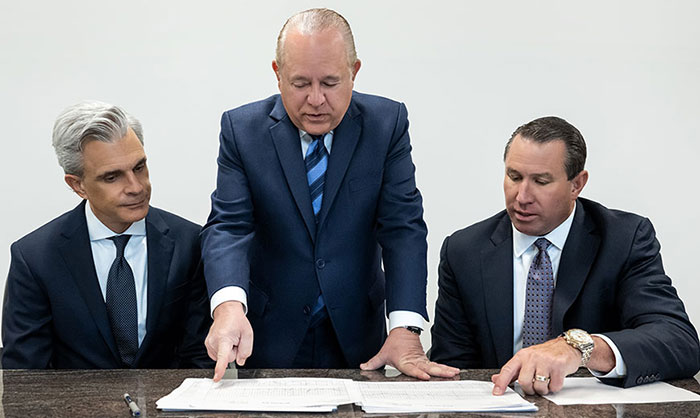
Why Should You Talk with the Knowledgeable Attorneys at Miller Weisbrod?
The only way to find out if you have a birth injury case is to talk to an attorney who understands birth injury.
At Miller Weisbrod, a team of committed professionals uses our detailed case review process to assess your potential claim. They start by learning more about you and your child. Then we gather medical records to determine what happened before, during, and after your delivery. We call in skilled medical experts who review your records and let us know if they think medical errors could have caused your child’s injuries.
If we feel medical malpractice was present, we meet with you to discuss how you can receive compensation from the medical professionals who made the errors. At no point in our legal intake process will we ask you to pay anything. The medical review of your case and the consultation are free. We only receive payment when you do.
